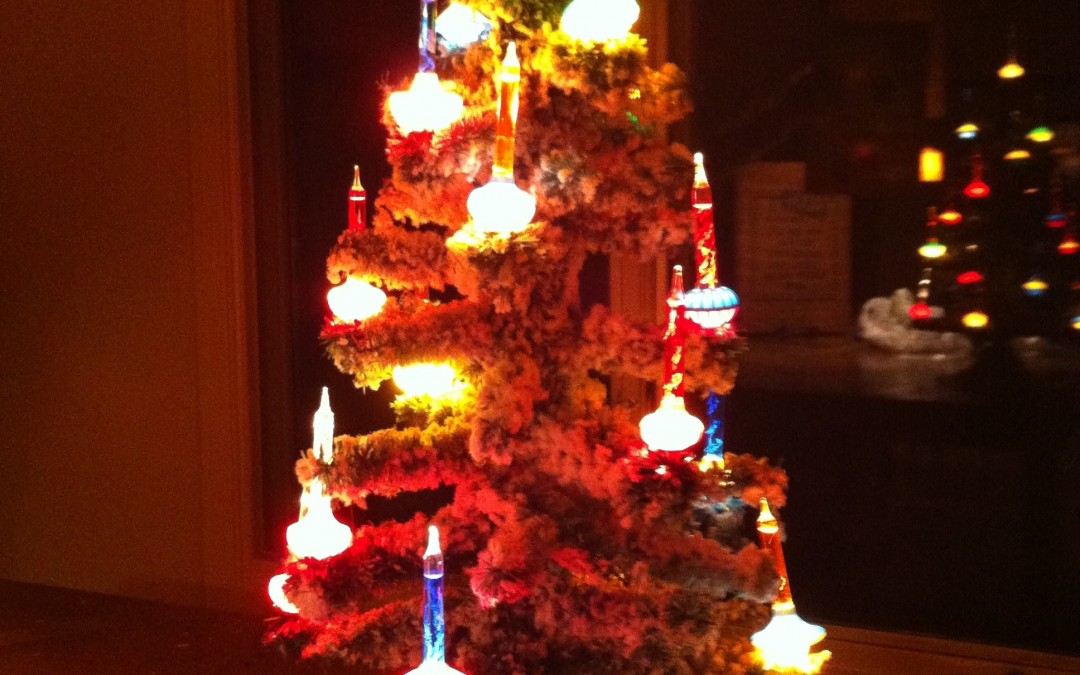Christmas casts its rosy glow over the past for many people, and for me. And if the season is sentimental and softening, if it dims the vision and favors fond detail over narrative, it is also true that the snow lay deep in December in the town I grew up in, and houses were gilded with lights, and on Christmas Eve, in our matching pajamas, we were driven in the big car through the neighborhoods we knew, and places we’d never been, kneeling up to look out the back seat windows, scrubbing away the fog of our own breath with our flannelled elbows. It was all primary colors and Santas in sleighs and Nativity sets in a shed made of plywood and filled with hay. Through picture windows, the trees were twinkling, some green like our own, but others puffily frosted in white and a few entirely silver and metallic and turning. I always wondered why the extension cords didn’t wind up and tip them over.
Continuous carols played on the radio. The snow fell. We see the season in a kind of double vision, don’t we? We see what is before us and also what is no longer there, and everything through the soft tunnel of memory. My mother, for example, remembers midnight Mass, and that would have meant the seeing-the-lights trip on another night, or at least no pajamas. No matter, no matter.
We had no picture window at the house on Braeburn, but we did have a tremendous fireplace in the living room, and its outside face was trimmed, I think, by a wreath. Or am I making that up? I do remember the moment of pulling back into our own driveway after seeing the town, and some dim contentment about the look of our own house. It was beautiful, with large windows and an oaken front door framed in glass. There was a coach light, I think, and it would have been trimmed for the season in greenery and light. We ran up the sidewalk in our pajamas and our boots, past the three cutout caroling choirboys, and tumbled in under the tree for cocoa in the special Santa cups and one package to open from the wrapped piles, carefully separated into three, and later four, stacks. My small sister, burdened early with a sense of aesthetics, or perhaps justice, would have spent hours arranging the piles so that they appeared exactly the same size, with the same, well, curb appeal.
Wrapped packages, cups of cocoa, candles lit on the mantel above the fire. Decades later, and in the absence of corroboration, it could be a single moment made iconic by time or many Christmases strung together, the way old home movies can be joined into a single reel. I cannot see a way to be sure.
I do remember hiding under the tree, which stood in a corner of the high-ceilinged living room. Our trees were not bushy or thick, but they were very tall, with long, spare branches (my mother said the balsams showed off the ornaments better), and the metal stand stood them off the floor some little distance. There was room for a small girl to wriggle under and lie on her back safe in the corner, where no one could see. Sometimes I took a little pillow to soften the unyielding floor. Looking up was gazing into a complex star system of branches and shiny ornaments and cords and light. The end of every branch was heavy with tinsel, each shimmery strand separately hung for maximum sparkle. They moved a little with my breath, and in the air of the room as people moved by, speaking, unaware of me.
It was a Christmas secret.
From “How The Bubble Tree Came To Me”, in my book Singing All The Verses: Essays From A Mid-American.







































